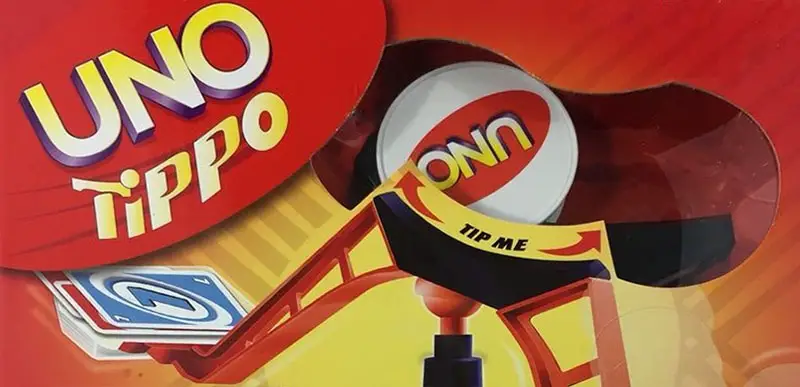
Components
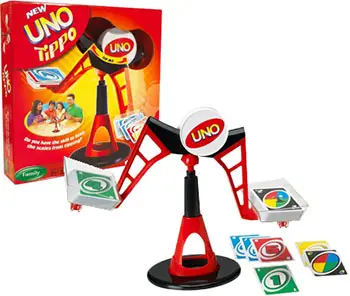
- 1 UNO Tippo Scale (8 pieces)
- 1 Disk
- 19 Blue Cards - 0 to 9
- 19 Green Cards - 0 to 9
- 19 Red Cards - 0 to 9
- 19 Yellow Cards - 0 to 9
- 8 Draw Two Cards
- 8 Reverse Cards
- 8 Skip Cards
- 4 Wild Cards
- 4 Wild Draw Four Cards
- 4 Tilt Cards
Object of the Game
Discard with caution! Attempt to keep the scales from tipping as you race to be the first player to get rid of all of your cards!
You'll score points in each round for the cards your opponents are left holding. Points in rounds accumulate and the first player to reach 500 points wins.
Assembly of the Scale
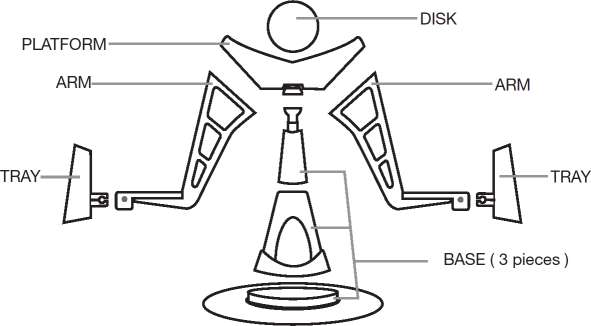
The scale consists of 8 pieces: 2 trays, 2 arms, 1 platform, and 3 pieces that make up the base. Assemble the scale pieces together as shown.
When snapping a tray onto an arm, hold the tray perpendicular to the arm with the opening facing outward and the narrow side up, as shown. When the tray is flipped into position for holding cards, the narrow side should be against the arm.
When finished playing, all pieces can be disassembled to store back in the box.
Setup
Place the scale in the center of the playing area and set the disk on the platform at the top of the scale.
Each player draws a card; the player that draws the highest number deals (count any card with a symbol as zero).
The dealer shuffles and deals each player 7 cards.
Place the remainder of the deck facedown to form a DRAW pile.
The top two cards of the DRAW pile are turned over to begin two DISCARD piles. Place one card face-up in each of the discard trays on the scale.
Note: If any of the Action Cards (symbols) are turned over to start the DISCARD pile, disregard the action (the first player does not have to perform it); the player to go first chooses the color of any Wild card turned over.
Game Play
The person to the left of the dealer starts play.
On your turn, you must match a card from your hand to a card on the top of either of the DISCARD piles, either by number, color or symbol (symbols represent Action Cards).
When you discard a card in one of the trays, you must make sure that the card is all the way in the tray.
If it's your turn and you don't have a card that matches the top card on either DISCARD pile, you must take a card from the DRAW pile. If the card you picked up can be played, you are free to put it down in the same turn. Otherwise, play moves on to the next person in turn.
Whenever an Action card is played, the next player must follow that action regardless of what is on top of the other tray.
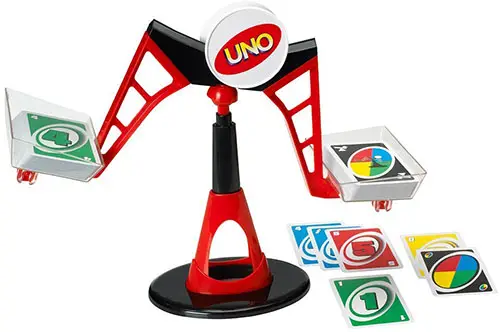
Tipping & Resetting The Scale
When you discard a card in one of the trays, if the scale tips so far that the cards are dumped out, you must draw 2 cards as a penalty! Even if it takes a while for the cards to spill out of a tray, the last player to make a play (discard or draw) takes the 2-card penalty.
Whenever the scale dumps cards, reset the scale by placing the top 2 cards in each DISCARD pile back in their respective trays and set all other cards aside. The cards set aside can later be reshuffled if the DRAW pile becomes depleted.
Action Cards
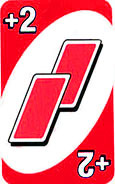
Draw Two Card
When you play this card, the next player must draw 2 cards and miss their turn. This card may only be played on a matching color or on another Draw Two card.
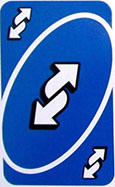
Reverse Card
When you play this card, the direction of play reverses (if play is currently to the left, then play changes to the right, and vice versa).
This card may only be played on a matching color or on another Reverse card.
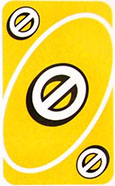
Skip Card
When you play this card, the next player is "skipped" (loses their turn).
This card may only be played on a matching color or on another Skip card.
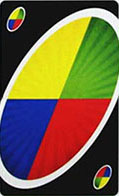
Wild Card
When you play this card, you get to choose the color that continues play (any color including the color in play before the Wild card was laid down).
You may play a Wild card on your turn even if you have another playable card in your hand.
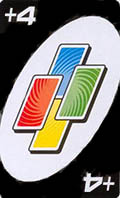
Wild Draw 4 Card
When you play this card, you get to choose the color that continues play PLUS the next player must draw 4 cards from the DRAW pile and lose their turn.
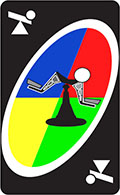
Tilt Card
When you play this Wild card, someone will be forced to tip the scales!
Starting with the next player and going in order of play, all players-including you-take turns drawing one card from the draw pile and placing it in the same tray as the Tilt card.
Continue doing this until the scale tips and spills the cards; the player who discarded the last card draws 2 cards as a penalty. Reset the scale with the top 2 cards in each tray.
The player after whoever tipped the scales is next, and play resumes in the current direction.
Note: If the last card discarded was an Action card, the next player must follow that action.
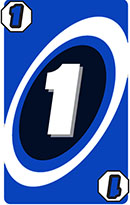
Stop Cards (20)
Five cards of each color (numbers 1 through 5) have an octagon shape around the number indicating they are Stop cards. You'll play one of these cards like you would any number card -by matching color or number.
However, playing one of these cards may put a stop to your ability to discard in that tray-which risks unbalancing and possibly tipping the scale! See STOP! for more details.
Stop
The 2 most important things to remember about Stop cards are:
-
Whenever there is ONE visible Stop card, that tray is stopped; no player can discard on it.
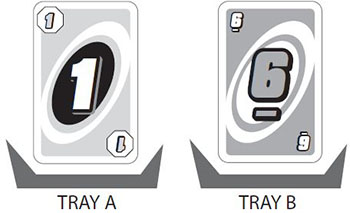
OR
-
Whenever there are TWO visible Stop cards, both trays are open and playable (because they cancel each other out).
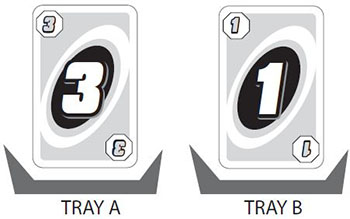
The 2 scenarios above are ALWAYS true no matter what else happens in subsequent turns.
There are 2 ways to open a stopped pile:
Playing any Wild card on top of a Stop card opens that pile for play.
Playing a Stop card in the other tray opens both piles for play.
While one pile is stopped, players continue to play by discarding in the remaining open tray.
You can play a Stop card on top of another Stop card (as long as color or number of both Stop cards match), but the most recent Stop card played is then visible in that tray. However, you cannot play a number card that is not also a Stop card on top of a Stop card.
Remember, if there are two visible Stop cards, both trays are open. But once someone covers one of the Stop cards, the other becomes the only Stop card visible and that tray is stopped.
Going Out
When you play your next-to-last card, you must yell "UNO" (meaning "one") to indicate that you have only one card left. If you don't yell "UNO" and you are caught before the next player begins their turn, you must draw two cards.
Once a player has no cards left, the round is over. Points are scored (see SCORING) and play starts over again.
If the last card played in a round is a Draw Two or Wild Draw Four card, the next player must draw the 2 or 4 cards respectively. These cards are counted when the points are totaled.
If the last card played is a Tilt card, all players still have to take turns discarding until the scale tips; that means the player who tried to go out by discarding it risks having the scale tip and earning the 2-card penalty!
If no player is out of cards by the time the DRAW pile is depleted, the DISCARD cards that were set aside are reshuffled and play continues.
Scoring
The first player to get rid of their cards in a round receives points for all of the cards left in their opponents' hands as follows:
- All number cards (0-9: Face Value
- Draw Two: 20 Points
- Reverse: 20 Points
- Skip: 20 Points
- Wild: 50 Points
- Wild Draw Four: 50 Points
- Tilt: 50 Points
Once the score for the round has been tallied, if no player has reached 500 points, reshuffle the cards and begin a new round.
End of the Game
The winner is the first player to reach 500 points.
Other Uno Games
- UNO Angry Birds
- UNO Attack
- UNO Blast
- UNO Boom-o
- UNO BTS
- UNO ColorAdd
- UNO Emoji
- UNO Dare
- UNO Dice
- UNO Chicago Cubs
- UNO Flash
- UNO Flip
- UNO Frozen II
- UNO Harry Potter
- UNO Minecraft
- UNO Monster High
- UNO MOD
- UNO Moo
- My First UNO
- UNO Original
- UNO Power Grab
- UNO Roboto
- UNO Royal Revenge Game
- UNO The Lion King
- UNO Spin
- UNO Splash
- UNO Stacko
- UNO Super Mario
- UNO Unocorns
- UNO Wild Jackpot
Continue Reading


